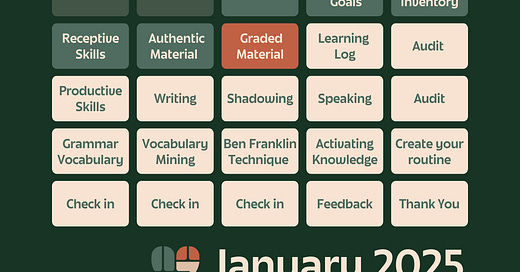For the month of January, I’ll be sharing quick posts to help you build a sustainable and joyful language learning practice. This series, Fresh Foundations, is all about actionable steps you can take in just 15-30 minutes a day to create a language learning routine that works for you.
If that sounds like something you’re ready for, let’s get into today’s activity!
Yesterday we chose an authentic source to work with this month and today we’re going to focus on choosing graded material to use as input for our target language.
What are Graded Materials Exactly?
Graded materials are resources simplified for language learners. Unlike authentic materials made for native speakers, graded content focuses on clear, level-appropriate language and introduces new vocabulary and grammar gradually.
Why Use Graded Materials?
Here’s why graded materials should be part of your language toolkit:
Build Confidence: Because they match your level, you’ll feel successful and motivated.
Reinforce Key Language Skills: Gradual exposure to new grammar and vocabulary strengthens comprehension.
Focus Your Learning Energy: Since they’re easier to understand, you can focus on active learning—taking notes, summarizing, or practicing speaking.
What to Look For
The key is to find materials that offer 80%-90% comprehension. Most of the words and ideas should feel familiar, but a small portion should challenge you to grow. If you’re understanding less than 80%, the material may be too advanced—try something simpler for faster progress.
Where to Find Graded Materials
It would be impossible for me to list content for every language, so I’m just going to give a few ideas here. However, please share your favorite resources in the comments for other learners to try! (Most of the materials I’m sharing below come from a Google search, so I’m not personally recommending them!)
Graded Readers:
English: Oxford Bookworms, Cambridge English Readers, and Penguin Readers for English learners. (I’ve used to run a reading program in a language school using Oxford Bookworms. I can recommend them especially for kids and teens learning English!)
Spanish: Lector.es
French: Lectures CLE en français facile
Podcasts:
News in Slow These news-based podcasts are great if you’re learning Spanish (Latino or España), German, Italian or French.
Coffee Break Languages Offers short episodes in 10 languages. They also offer graded readers and television programs. (This is not a sponsored post. I’ve listened to their Coffee Break Italian podcast, but have just come across the other resources they offer!)
YouTube:
Search for CEFR-labeled videos (e.g., B1 Russian, B2 German) or channels focused on intermediate-friendly content like Spanish Playground or Français avec Pierre.
Your Task
Choose one graded material resource—whether it’s a podcast, book series, or YouTube channel—and commit to it for the next month.
Bookmark the website or
Create a playlist or
Save the links in a language learning app or notebook or
Add it to your list of material (either add it to the list your downloaded yesterday or download the pdf again).
Once you’ve chosen, share your pick in the comments. Let’s support each other by exchanging ideas and holding each other accountable.
Tomorrow we’ll start actively working with the materials we’ve collected the past two days. Looking forward to seeing you tomorrow!






I've chosen Duolingo French podcast for my January learning month :D